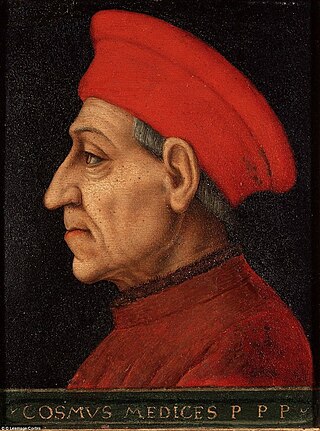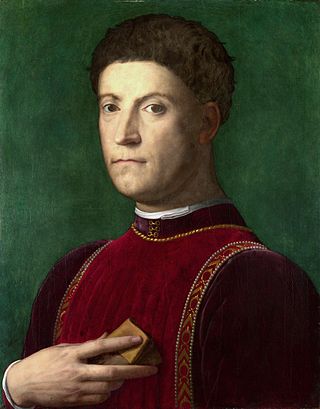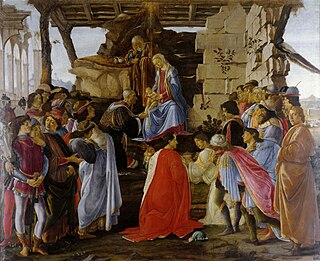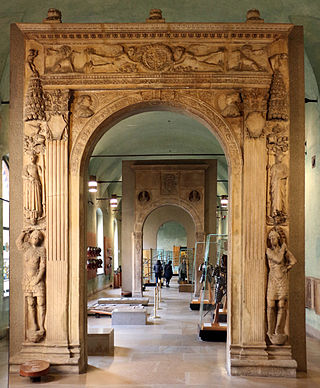
Trattato di architettura is a book on architectural theory by the Florentine Renaissance architect Filarete completed c. 1464.

Trattato di architettura is a book on architectural theory by the Florentine Renaissance architect Filarete completed c. 1464.
Filarete's book was dedicated to Francesco Sforza, with Filarete naming the text "Libro Architecttonico." The book contains 25 parts (each of which Filarete termed a "libro"), with most of the parts being finished during his stays in Milan. After his last stay in Milan, he turned to Florence, and during his travel he wrote the final part of his book. A dedication was expected to be made to the Medici family, and later he added another dedicatory to Piero di Cosimo de' Medici.
According to research by Giorgio Vasari, the last two additions to "Libro Architecttonico" were finished in roughly 1464, and his contemporary scholars have determined this information to be correct. For the previous 24 books, Spencer[ citation needed ] proposed the years between 1461 and 1462 for the first 21 books, later [ when? ] for books 22-24 on drawings, and the last one book for Medici. While Grassi Liliana thought the books would be finished during 1460 and 1461, he also thought the revision would be later, potentially in 1464. [1]
The books of Filarete were considered manuscripts for a time, split into two groups. The first group contains two sections, the first was dedicated to Francesco Sforza. The second section, dedicated to Piero di Cosimo de' Medici, is also known as "Codex Magliabechiano" and contains illustrations. The second group of content was written in Latin for Matthias Corvinus, and it was strongly influenced by the work of Vitruvius. [1]
Filarete′s books have a narrative structure. In the books, he imagines that Francesco Sforza needs him to plan a new city, called Sforzinda. Filarete is in charge of this work and finds the "Golden Book," a mythical text about the fictional city of Plugiapolis written by an ancient king, Zogalia. The "Golden Book" gave him the idea for the new city. The central part of the Filarete′s books describe the city and the buildings inside of it. The city has the shape of an eight point star, circumscribed by a circle. The city includes three important public spaces: the palace, the market, and the cathedral. However, he did not give a concrete plan for a particular project. [2]


Filarete's plan was not only retained on paper. The "Ospedale Maggiore" in Milan, known as "Ca′ Granda", was built by Duke Francesco Sforza in 1456, according to Filarete's plan. However only the southern part of the building was built directly according to his design, while the latter transformation of the building was still greatly influenced by his plan and philosophy. [3]
In 1890 von Oettingen published the first draft of the book, and latter added an introduction by Lazzarom and Munoz in 1908. In 1963, Tigler, published his dissertation and book "Die Architecturtheorie des Filarete." [4] Further, an English translation and a critical edition in Italian were published in 1965. [1]

Francesco I Sforza was an Italian condottiero who founded the Sforza dynasty in the duchy of Milan, ruling as its (fourth) duke from 1450 until his death. In the 1420s, he participated in the War of L'Aquila and in the 1430s fought for the Papal States and Milan against Venice. Once the war between Milan and Venice ended in 1441 under mediation by Sforza, he successfully invaded southern Italy alongside René of Anjou, pretender to the throne of Naples, and after that returned to Milan. He was instrumental in the Treaty of Lodi (1454) which ensured peace in the Italian realms for a time by ensuring a strategic balance of power. He died in 1466 and was succeeded as duke by his son, Galeazzo Maria Sforza. While Sforza was recognized as duke of Milan, his son Ludovico would be the first to have formal investiture under the Holy Roman Empire by Maximilian I in 1494.

Ludovico III Gonzaga of Mantua, known as the Turk, also spelled Lodovico was the ruler of the Italian city of Mantua from 1444 to his death in 1478.

Cosimo di Giovanni de' Medici was an Italian banker and politician who established the Medici family as effective rulers of Florence during much of the Italian Renaissance. His power derived from his wealth as a banker, and inter-marriage with other powerful and rich families. He was a patron of arts, learning, and architecture. He spent over 600,000 gold florins on art and culture, including Donatello's David, the first freestanding nude male sculpture since antiquity.

The Republic of Florence, known officially as the Florentine Republic, was a medieval and early modern state that was centered on the Italian city of Florence in Tuscany, Italy. The republic originated in 1115, when the Florentine people rebelled against the Margraviate of Tuscany upon the death of Matilda of Tuscany, who controlled vast territories that included Florence. The Florentines formed a commune in her successors' place. The republic was ruled by a council known as the Signoria of Florence. The signoria was chosen by the gonfaloniere, who was elected every two months by Florentine guild members.

Piero di Cosimo de' Medici, known as Piero the Gouty, was the de facto ruler of Florence from 1464 to 1469, during the Italian Renaissance.

Michelozzo di Bartolomeo Michelozzi was an Italian architect and sculptor. Considered one of the great pioneers of architecture during the Renaissance, Michelozzo was a favored Medici architect who was extensively employed by Cosimo de' Medici. He was a pupil of Lorenzo Ghiberti in his early years, and later collaborated with Donatello.

Vincenzo Foppa was an Italian painter from the Renaissance period. While few of his works survive, he was an esteemed and influential painter during his time and is considered the preeminent leader of the Early Lombard School. He spent his career working for the Sforza family, Dukes of Milan, in Pavia, as well as various other patrons throughout Lombardy and Liguria. He lived and worked in his native Brescia during his later years.

The Castello Sforzesco is a medieval fortification located in Milan, Northern Italy. It was built in the 15th century by Francesco Sforza, Duke of Milan, on the remnants of a 14th-century fortification. Later renovated and enlarged, in the 16th and 17th centuries it was one of the largest citadels in Europe. Extensively rebuilt by Luca Beltrami in 1891–1905, it now houses several of the city's museums and art collections.

Antonio di Pietro Aver(u)lino, known as Filarete, was a Florentine Renaissance architect, sculptor, medallist, and architectural theorist. He is perhaps best remembered for his design of the ideal city of Sforzinda, the first ideal city plan of the Renaissance.

Francesco di Giorgio Martini (1439–1501) was an Italian architect, engineer, painter, sculptor, and writer. As a painter, he belonged to the Sienese School. He was considered a visionary architectural theorist—in Nikolaus Pevsner's terms: "one of the most interesting later Quattrocento architects". As a military engineer, he executed architectural designs and sculptural projects and built almost seventy fortifications for the Federico da Montefeltro, Count of Urbino, building city walls and early examples of star-shaped fortifications.

Sforzinda is a visionary ideal city named after Francesco Sforza, then Duke of Milan. It was designed by Renaissance architect Antonio di Pietro Averlino, also known as "Averulino" or "Filarete".

The Policlinico of Milan also known as Ospedale Maggiore di Milano or Ca' Granda Ospedale Maggiore Policlinico, is the public district general hospital in Milan, It is one of the oldest hospitals in Italy, founded by Duke Francesco Sforza in 1456. Today it is a modern hospital with 900 beds, with wards for adults, pregnant women and children. During the first COVID-19 breakout in March 2020, 300 of those beds were readapted for COVID-19 patients.
The decade of the 1460s in art involved some significant events.

The Adoration of the Magi is a painting by the Italian Renaissance master Sandro Botticelli. Botticelli painted this piece for the altar in Gaspare di Zanobi del Lama's chapel in Santa Maria Novella around 1475. This painting depicts the Biblical story of the Three Magi following a star to find the newborn Jesus. The image of the altarpiece centers on the Virgin Mary and the newborn Jesus, with Saint Joseph behind them. Before them are the three kings who are described in the New Testament story of the Adoration of the Magi. The three kings worship the Christ Child and present him with gifts of gold, frankincense and myrrh. In addition, the Holy Family is surrounded by a group of people who came to see the child who was said to be the son of God.

Bernardo Rucellai, also known as Bernardo di Giovanni Rucellai or Latinised as Bernardus Oricellarius, was a member of the Florentine political and social elite. He was the son of Giovanni di Paolo Rucellai (1403–1481) and father of Giovanni di Bernardo Rucellai (1475–1525). He was married to Nannina de' Medici, the elder sister of Lorenzo de' Medici, and was thus uncle to Popes Leo X and Clement VII, who were cousins. Oligarch, banker, ambassador and man of letters, he is today remembered principally for the meetings of the members of the Accademia platonica in the Orti Oricellari, the gardens of his house in Florence, the Palazzo Rucellai, where Niccolò Machiavelli gave readings of his Discorsi.

Francesco di Antonio del Chierico (1433–1484) was a manuscript illuminator of the early Renaissance period in Florence. Francesco began as a goldsmith before changing occupations to become a successful illustrator. He was one of the pupils of Fra Angelico and became famous for being Lorenzo de' Medici's favorite illuminator. He worked under some of the most prestigious patrons of the time, including Lorenzo de' Medici, Piero de’ Cosimo de' Medici, Cosimo il Vecchio, and Vespasiano da Bisticci. He gained a reputation for his well executed illustrations in varying types of books ranging in size from small books of hours to large choir books. His illustrations often included intricate floral arrangements, putti, and candelabras. He decorated both the borders of manuscripts and full pages.

Medici is a historical drama television series created by Frank Spotnitz and Nicholas Meyer. The series was produced by Italian companies Lux Vide and Rai Fiction, in collaboration with Frank Spotnitz's Big Light Productions.

The Palazzo del Banco Mediceo or simply Banco Mediceo, was a palace in Milan, the Milanese seat of the Medici's financial exchange activities, known throughout Europe as the Medici Bank. It was one of the earliest examples of Lombard Renaissance architecture.